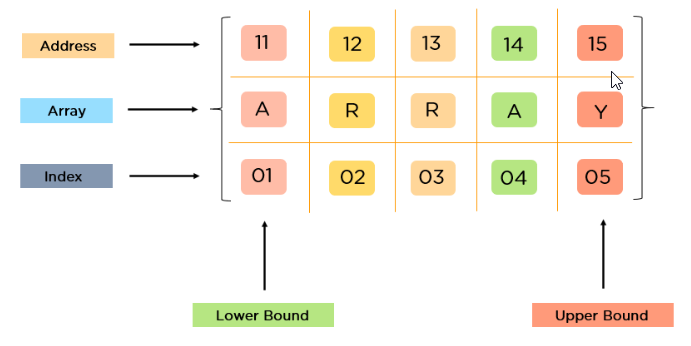An array is a fundamental kind of linear data structure. It’s like a container that can hold a bunch of items, which can be of the same type or different types. Arrays can be organized in a straight line, and they also support a more complex layout with multiple rows and columns. We use arrays when we want to gather a bunch of related things together in one location.
It is a collection of elements, each identified by an index or a key. Arrays provide a way to store multiple items of the same data type in a contiguous block of memory.
Basic terminologies of array

An array is a linear data structure that collects elements of the same data type and stores them in contiguous and adjacent memory locations. Arrays work on an index system starting from 0 to (n-1), where n is the size of the array.
Representation of Array
The representation of an array can be defined by its declaration. A declaration means allocating memory for an array of a given size.
Need for Arrays
Arrays are used as solutions to many problems from the small sorting problems to more complex problems like travelling salesperson problem. There are many data structures other than arrays that provide efficient time and space complexity for these problems, so what makes using arrays better? The answer lies in the random access lookup time.
Arrays provide O(1) random access lookup time. That means, accessing the 1st index of the array and the 1000th index of the array will both take the same time. This is due to the fact that array comes with a pointer and an offset value. The pointer points to the right location of the memory and the offset value shows how far to look in the said memory.

Certainly, let’s delve into more detail about arrays in the context of data structures and algorithms in C programming.
Basic Operations in the Arrays
The basic operations in the Arrays are insertion, deletion, searching, display, traverse, and update. These operations are usually performed to either modify the data in the array or to report the status of the array.
Following are the basic operations supported by an array.
- Traverse − print all the array elements one by one.
- Insertion − Adds an element at the given index.
- Deletion − Deletes an element at the given index.
- Search − Searches an element using the given index or by the value.
- Update − Updates an element at the given index.
- Display − Displays the contents of the array.
Array Declaration and Initialization:
You declare an array in C by specifying the data type of its elements and its name, followed by square brackets indicating its size.
int integerArray[5]; // Declaration of an integer array with size 5Arrays can also be initialized during declaration:
int primeNumbers[6] = {2, 3, 5, 7, 11, 13}; // Initialization of an integer arrayAccessing and Modifying Array Elements:
You access array elements using their index:
int thirdElement = primeNumbers[2]; // Access the third element (index 2)You can also modify array elements:
primeNumbers[4] = 17; // Modify the fifth element (index 4) to 17Array Indexing and Bounds:
Array indices start from 0, so if an array has n elements, valid indices are from 0 to n-1. Accessing an element outside this range can result in undefined behavior and memory access issues.
Multidimensional Arrays:
C supports multidimensional arrays, like 2D arrays (matrices) or even higher dimensions. A 2D array can be thought of as an array of arrays:
int matrix[3][4]; // Declaration of a 2D array with 3 rows and 4 columnsArray Operations:
Arrays support various operations, such as:
- Iterating through elements using loops (for, while, or do-while).
- Finding the minimum and maximum elements.
- Calculating the sum, average, or other aggregate values.
- Searching for an element using linear or binary search (for sorted arrays).
- Sorting elements using algorithms like bubble sort, insertion sort, or quicksort.
Limitations and Considerations:
Arrays have some limitations:
- Fixed size: Once an array is declared, its size is static and cannot be changed.
- Inefficient insertions and deletions: Inserting or deleting elements in the middle requires shifting elements, which can be time-consuming for large arrays.
For scenarios requiring dynamic sizing or efficient insertions/deletions, other data structures like linked lists or dynamic arrays may be more suitable.
Kali Linux vs. Parrot OS: A Comparative Analysis for Cybersecurity Professionals
In summary, arrays are a cornerstone of data structures and algorithms in C programming. They provide efficient storage and retrieval of data and are essential for various programming tasks. Understanding arrays is crucial for developing strong algorithmic and programming skills.
